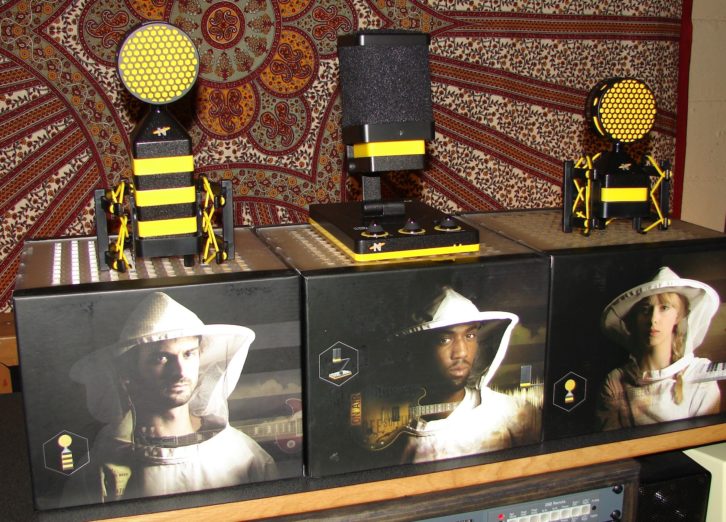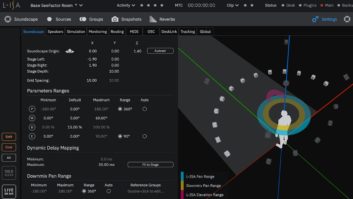
Newcomer Neat Microphones (with principal players from Blue and Gibson Pro Audio) has launched a line of very affordable mics that are demanding attention due to their low prices, bold bee-inspired yellowblack color schemes and some highly unusual design features. The $349 King Bee is a cardioid-only, 34 mm gold-sputtered diaphragm condenser with Class A discrete electronics, transformer at output and no pads or switches. It comes with a mandatory screwed-in shock mount and a unique pop filter—the latter, a perforated plastic cap lined with a layer of mesh, snapping directly onto the face of the semi-globe head basket. The $199 Worker Bee is simply a smaller version of the King with the same features, but a 25 mm diaphragm in a smaller form factor.
The $349 Beecaster stereo USB model is the most unique of the Neat bunch. It provides a quartet of 25 mm capsules arranged in an x array. Four polar patterns are available: mono, standard stereo, wide stereo and focused stereo. The only connections are USB (plug and play, no drivers needed) and an eighth-inch stereo headphone jack; the Beecaster can be selected as an output device by your computer and no latency monitoring is provided. The Beecaster is mounted on a heavy desktop base with articulating boom and a rotating swivel that provides substantial placement options.
Connected to a Millennia Media STT-1 mic amp (my standard bearer for quality and flexibility), I was surprised to find a somewhat dark, thick tonal signature with a baritone vocalist paired to the King Bee. I tried numerous preamp settings (tube, solid state and transformer) but found a lot of low-mid chestiness (almost a little growly), minimal sibilance, muted mouth-noises and a rather likable warm ’n husky kind of thing. I couldn’t track flat though, as I filtered out lots of low stuff (as I wished the King Bee had a high-pass filter) and shelf-boosted some top-end.
Tests with tenors, altos and instruments found the same results… the King Bee was pretty cool if you like a darker signature and have some EQ filters at hand to clean it up and clarify. However, on a drum kit, I found the qualities of the King Bee amplified into problems; those lows and low-mids were a bit too much and downright distorted with outside kick, snare and toms. I did get some useful tones on drum room where a little dark and dirty is quite okay, but the King’s very sculpted mids and peaky top-end weren’t complimentary colored in this case (where a ribbon mic or beefy condenser, in comparison, would likely do the trick). My Taylor acoustic guitar sounded pretty cool after some substantial EQ work.
I tried the Worker Bee alongside the King Bee and found the little one to be more to my liking. The two sound quite similar, except the Worker doesn’t have the extended bottom (or the muddiness). It has more sibilance, more clarity and more top end. The tone on vocals, guitars and instruments was generally clearer, more musical and required less EQ. I received good results when close-miking guitar amps; it’s not as well suited for powerful metal tones, but not bad for clean and brownish stuff. The Worker Bee took loud levels and sometimes sounded a little better with the windscreen on, which thickened up the bottom end.
Despite being much more useful with acoustic instruments, guitars and backup vocals, the results with drums weren’t so good. Too much distortion, harsh off-axis response, not enough SPL handling and too much non-linearity through the mids and top proved to be problematic. Unfortunately, the all-plastic shock mount gave out on me, but it remained usable for upright apps, like vox. Listen to the webclip with two Neat Bees on acoustic guitar here: http://bit.ly/1kOlj6c.
I tried out the Beecaster with some acoustic guitar and vocals, but just couldn’t achieve a pure enough tone. Sure, it was super-convenient to connect and the stereo patterns are marvelous (wide stereo is quite wide and a bit hollow, but it sounds really cool on two persons/sound sources), but the top end wasn’t present enough and the noise floor is quite loud. The heavy base, swivel and boom are absolutely fantastic, offering a wide range of steady movement and stability, perfect for desktop use.
I can be a picky guy, so I enlisted my webcasting friends at Plaza Midwood Community Radio (pmcradio.org), who indeed got more satisfaction from the Beecaster than I did. They concurred on the wide stereo pattern, found the mute (cough) button useful, loved that firm swivel/ boom as much as I did, didn’t like the cool-looking pop filter (it’s kind of flimsy), claimed to get good results on both guitars and vocals (when recording music) and didn’t mind the noise floor! As usual, mileage will vary.
All in all, I liked the Worker the most for its reasonable versatility, especially when coupled with the frequency-smoothing, transient-reducing pop filter. My mixed feelings about the King left me neutral, as I could find interesting things to do with it, but novices may have trouble without a comprehensive front-end toolkit. I absolutely loved the Beecaster except for its noise floor—a deal-breaker for me, if not for everyone.
I don’t believe this line from Neat will satisfy the most discriminating pros, as the units’ uneven frequency response, distortion and design quirks preclude that (e.g., the shockmounts are secure but saggy, the clutches fail, and the pop filters, albeit clever, don’t hold together). But for newbies, they should be considered for their very low prices, useful tones on quiet sources and a general fun factor in use.







